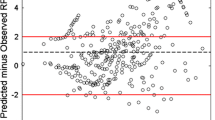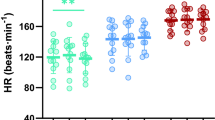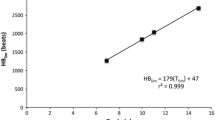Abstract
The purpose of this study was to examine the validity of the use of ratings of perceived exertion (RPE) to estimate and regulate exercise intensity during rowing ergometry. Nine competitive male rowers [mean age 28.6 years, (SD 6.3)] completed two rowing trials on an ergometer. The first trial (estimation) consisted of an incremental protocol designed to elicit a range of work outputs (WO) and heart rates (HR). The subjects indicated their perception of effort using a 15-point scale at each intensity level. In the second trial (production), 7–14 days later, the subjects were asked to produce exercise intensities corresponding to five levels of RPE: 15,11,17,13, and 19. Data analysis revealed high Pearson correlation coefficients between HR and RPE (r = 0.95,P < 0.01) and WO and RPE (r = 0.96,P < 0.01) during the estimation trial. In addition, significant correlations (P < 0.01) were obtained between the estimation and production trials for HR (r = 0.82) and WO (r = 0.84). Posthoc analysis of variance revealed that the observed differences in mean HR were not significant (P > 0.05) at three of the five intensity levels (RPE 15,17 and 19), but were at the two lowest RPE levels (11 and 13). Significant mean differences in WO were seen at all but RPE 17. These data support the validity of the RPE scale as a measure of physiological strain among competitive male rowers, and offer support for its use as a method of regulating the intensity of rowing ergometry, especially at higher levels.
Similar content being viewed by others
References
Arstilla M, Wendelin H, Vuori I, Valimaki I (1974) Comparison of two rating scales in the estimation of perceived exertion in a pulse-conducted exercise test. Ergonomics 17:577–584
Bar-Or O, Skinner JS, Buskirk ER, Borg G (1972) Physiological and perceptual indicators of physical stress in 41- to 60-year-old men who vary in conditioning level and in body fatness. Med Sci Sports Exerc 4:96–100
Bayles CM, Metz KF, Robertson R, Goss FL, Cosgrove J, McBurney D (1990) Perceptual regulation of prescribed exercise. J Cardiopulmon Rehabil 10:25–31
Borg GAV (1962) Physical performance and perceived exertion. Studia Psychologia et Paedogogica Serles Altera, Investigationes XI. Gleerup, Lund pp 39–40
Borg GAV (1970) Perceived exertion as an indicator of somatic stress. Scand J Med 2:92–98
Borg GAV (1982) Psychophysical bases of perceived exertion. Med Sci Sports Exerc 14:377–381
Borg GAV (1985) An introduction to Borg's RPE-Scale. Mouvement Publications, New York, pp 23–25
Borg GAV, Linderholm H (1967) Perceived exertion and pulse rate during graded exercise in various age groups. Acta Med Scand [Suppl] 472:194–206
Borg GAV, Hassmen P, Lagerstrom M (1987) Perceived exertion related to heart rate and blood lactate during arm and leg exercise. Eur J Appl Physiol 56:679–685
Carton RL, Rhodes EC (1985) A critical review of the literature on rating scales for perceived exertion. Sports Med 2:198–222
Chow RJ, Wilmore JH (1984) The regulation of exercise intensity by ratings of perceived exertion. J Cardiac Rehabil 4:382–387
Dishman RK (1994) Prescribed exercise intensity for healthy adults using perceived exertion. Med Sci Sports Exerc 26:1087–1094
Dunbar CC, Robertson RJ, Baun R (1992) The validity of regulating exercise intensity by ratings of perceived exertion. Med Sci Sports Exerc 24:94–99
Dunbar CC, Goris C, Michielli DW, Kalinski MI (1994) Accuracy and reproducibility of an exercise prescription based on ratings of perceived exertion for treadmill and cycle ergometer exercise. Percept Mot Skills 78:1335–1344
Edwards RHT, Melcher A, Hesser CM, Wigertz O, Ekelund LG (1972) Physiological correlates of perceived exertion in continuous and intermittent exercise with the same average power output. Eur J Clin Invest 2:108–114
Eston RG, Davies BL, Williams JG (1987) Use of perceived effort ratings to control exercise intensity in young healthy adults. Eur J Appl Physiol 56:222–224
Glass SC, Knowlton RG, Becque MD (1992) Accuracy of RPE from graded exercise to establish exercise training intensity. Med Sci Sports Exerc 24:1303–1307
Harrison D, Howe B (1992) Accuracy of perceived exertion in anaerobic threshold training for rowing. FISA Coach 3:5–9
Morgan WP, Borg GAV (1976) Perception of effort in the presecription of physical activity. In: Craig TT (ed) Humanistic and mental aspects of sports, exercise and recreation. American Medical Association, Chicago, pp 126–129
Robertson RJ (1982) Central signals of perceived exertion during dynamic exercise. Med Sci Sports Exerc 14:390–396
Skinner JS, Borg G, Buskirk ER (1969) Physiological and perceptual reactions to exertion of young men differing in activity and body size. In: Franks BD (ed) Exercise and fitness. Athletic Institute, Chicago, pp 53–66
Skinner JS, Hutsler R, Bergsteinova V, Buskirk ER (1973) The validity and reliability of a rating scale of perceived exertion. Med Sci Sports Exerc 5:94–96
Smutok MA, Skrinar GS, Pandolf KB (1980) Exercise intensity: subjective regulation by perceived exertion. Arch Phys Med Rehabil 61:569–574
SPSS for Windows (1993) Version 6.01. SPSS Inc, Chicago
Turkulin K, Zamlic B, Pegan U (1977) Exercise performance and perceived exertion in patients after myocardial infarction. In: Borg G (ed) Physical work and effort. Pergamon Press, Oxford, pp 357–366
Watt B, Grove R (1993) Perceived exertion-antecedents and applications. Sports Med 15:225–241
Author information
Authors and Affiliations
Rights and permissions
About this article
Cite this article
Marriott, H.E., Lamb, K.L. The use of ratings of perceived exertion for regulating exercise levels in rowing ergometry. Europ. J. Appl. Physiol. 72, 267–271 (1996). https://doi.org/10.1007/BF00838650
Accepted:
Issue Date:
DOI: https://doi.org/10.1007/BF00838650




